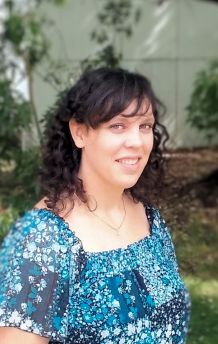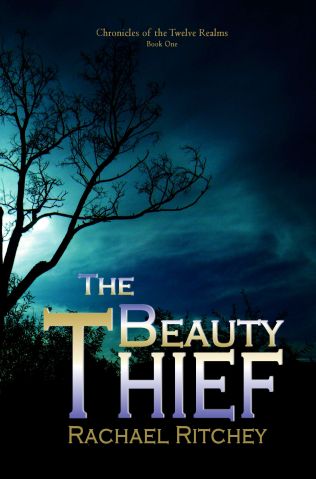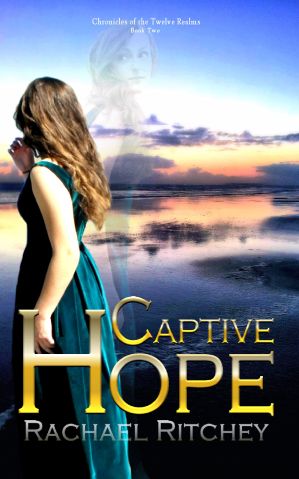For today’s blog, we’re going to interview a self-published author that’s already a few stops down the road I’m trying to walk. Today, we are interviewing Rachael Ritchey as part of her Blog Tour as she gets ready to release her second book: Captive Hope.

Sign up on her mailing list to enter for a chance to win a free copy of Captive Hope!
So without further preamble –
SYF: How did you get started writing?
RR: I had an idea that just wouldn’t stop nagging at me. I’ve always loved writing, at least since junior high, but I never felt qualified to actually write anything worthwhile. My life experience has been so small, but that idea . . . it just wouldn’t leave me be.
SYF: Your first book was The Beauty Thief – How long did it take you to write it?
RR: Yes, the nagging story! It went in stages, but overall it took about eleven months. I spent the first week writing a short story, an honest to goodness fairytale. After that I spent a few days fleshing out the arc of the story with more details. It was an outline but definitely didn’t look like one. The first draft took four months. During that process I continued to edit and edit again, (which is not the recommended course of action). I edited two more times before obtaining several beta readers/critique partners. By this time I was about six months into the process. This portion took another month to six weeks then more editing. A little more editing then it went to my editor before I edited again. Then it was proofread once more before galleys were ordered and proofed again. It’s a long process but so worth it!
SYF: Wow, so it sounds like you did some editing. Now for that age old question – Pantser or Plotter? IE: Do you outline or write off the cuff?
RR: Ah yes, the panster vs plotter dichotomy. It may seem a stretch, but I’m actually a combination of the two. I do basic plots and outlines, but there is a wild panster living in me. She loves to chase the rabbits and see where they lead. I suppose you could say that I plan and plot, but am not so rigid that I can’t see the forest for the trees.
SYF: Do you use any specialized software or other tools in doing your writing?
RR: For the actual writing I switch back and forth between Microsoft Word and Scrivener. I do the bulk of the writing in Scrivener, but Word is where I format everything for editing and final publishing. I love the organization Scrivener provides.
SYF: I actually love Scrivener as well. (For those not familiar, my post on Scrivener) Once you finished, what made you decide to self-publish?
RR: I spent every day of the writing process debating the idea of traditional publishing vs. self-publishing. Because I really had no idea how either option worked, I started doing research on both. It boiled down to creative control and the fact that even with a traditional publisher I’d be left doing most of the marketing for my books, which is the one thing I really didn’t want to do. If I was going to have to do that I figured I might as well do the rest, too. That being said, I learned about what goes into making a great book, and I strive to meet quality expectations for content, product look, and marketing.
SYF: What’s been the biggest lessons learned in self-publishing?
RR: You don’t have to do it alone. There are resources and people available to help make your book the best it can be. And editing may seem expensive but it’s a must to producing quality content. Make sure you find an editor that does examples of their skill on your own work, are not afraid to point you to other books they’ve edited, and follow a manual of style that is standard for the country in which you live and publish. Just because you self-publish doesn’t mean your content cannot meet the same standards of traditionally published works.
SYF: Your second book, Captive Hope, is about to come out. Exciting! How was the writing process for this one compared to The Beauty Thief?
RR: The story developed in a similar fashion to the first book. I decided to start writing it during National Novel Writing Month (NaNoWriMo) to get a leg up on finishing it. I completed the first 50,000 words in twenty days, but that was only half the novel. I had to take a long break in the middle when I received my manuscript for The Beauty Thief back from my editor, Susan Hughes. I had a lot more confidence in my ability when writing the second one.
SYF: That’s awesome. I’m also a big NaNoWriMo fan. Any other words of wisdom or advice you’d like to give our readers?
RR: Both self-publishing and traditional publishing routes are full of difficulty, frustration, pitfalls, and sweet success. Whichever you choose, take it seriously and just do your best. Do not let discouragement keep you from moving forward with your dream. Make friends with other published and unpublished authors. And never stop learning!
——–
A big thank you to Rachael for taking time to give us some insight into her writing journey. I for one am extremely excited to walk a similar road and one day join her on the book shelves. In the mean time, you should absolutely check out her books.


Reblogged this on Chronicles of the Twelve Realms and commented:
Please stop by Start Your Fiction today and read the latest from the Captive Hope Book Blog Tour.
Here’s a quote from the post: “Do not let discouragement keep you from moving forward with your dream.”
Thanks for having me over to your blog today, Jon!
LikeLiked by 1 person
Thanks for making me a stop on your tour! Happy to post. Good luck with the book!
LikeLiked by 1 person
I’m honored to be hosted on your blog, Jon. It means so much to me to have kind people such as yourself step up and help me! You are taking time out of your day to do it, and I know how precious that is! I’m looking forward to watching your progress toward your own publishing goals! 🙂
LikeLiked by 1 person
This is a great post! I am one of Racheal’s other hosts and I wanted to see how everyone else’s posts have been going. I hope you guys are having a great day!
LikeLiked by 2 people
Thanks for coming by! I’m looking forward to checking out some of the other hosts as well!
LikeLiked by 1 person
Thanks, Steven! It’s going to be great! 🙂 THANK YOU BOTH! 😀
LikeLiked by 2 people
Great interview and great advice. I need to make that decision soon, too. Need to stop procrastinating and just DO It. Thank you.
LikeLiked by 2 people
I hear us there! Thanks for reading!
LikeLiked by 1 person
Thanks for reading the interview, Claudia! Would love to connect more. You GOT this! 😉
LikeLiked by 1 person
Love the covers. Have yet to read The Beauty Thief. Fantastic interview. Way to go, Rachael. 🙂
LikeLiked by 2 people
Thank you so much, Tess! I hope that when you do get a chance to read it that you’ll enjoy it. 😀
LikeLiked by 1 person
Me too. I want to read all the books in my arsenal–I mean, library. Not only are my bookcases loaded, my Kindle app on my iPad is ready to e.x.p.l.o.d.e. I can’t keep up.
LikeLiked by 2 people
It’s a good problem but also overwhelming! 😛
LikeLiked by 2 people
*sigh* I’m afraid you’re right!
LikeLiked by 2 people
Great interview! I like visiting the other blog tour hosts. 🙂
LikeLiked by 1 person
Thanks for coming by!
LikeLiked by 1 person
I’m glad I did. 🙂
LikeLiked by 1 person